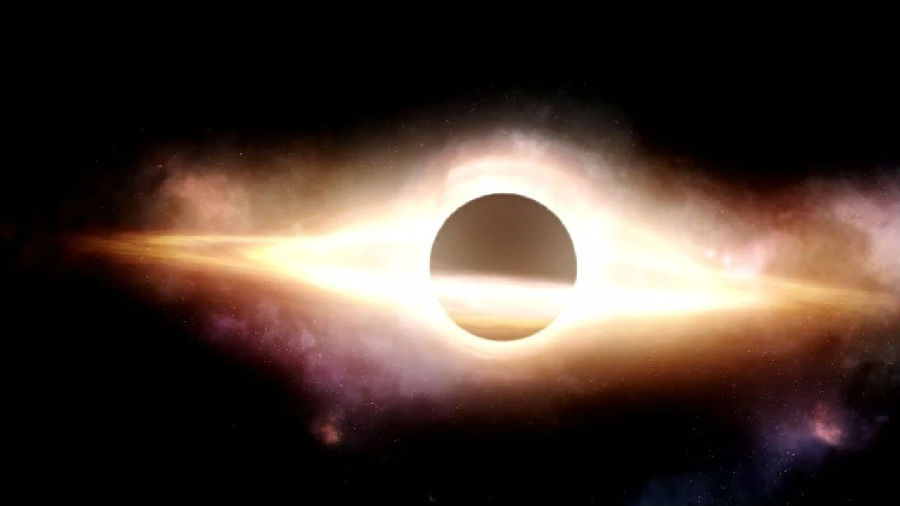Even though they, and nobody else, will be around to see it, scientists are fascinated by the end of the universe.
科学家一直对宇宙的末端深深着迷,虽然不管是他们自己还是其他人都根本看不到。
It's kind of like the Big Bang — there's just something so interesting about knowing where your atoms came from, and where they're ultimately going to go in billions of years.
就有点像宇宙大爆炸一样——了解组成我们的原子从何而来又去往何处是很有乐趣的一件事。
Right now, there are a few ideas about how everything could end, but many researchers seem to agree on what's called the Big Freeze
现在,关于万物如何消亡这个问题已经有了一些猜想,但很多科学家似乎都比较认同“大寒冷”的说法
(which we used to call heat death, but we've now rebranded)
(我们之前称其为热寂,但现在换了说法)。
where everything is spread so thin that activity basically stops.
所谓“大寒冷”,就是万物都紧密地挨着,所以移动几乎都停止了。

Except, based on the results from a paper published last week in Nature Astronomy, that might not actually be true.
不过,根据上周《自然天文学》上一篇论文的研究结果,“大寒冷”的猜测可能并不是对的。
Instead, there's a chance that everything in existence will eventually be ripped apart.
相反,有可能现有的万物最后都会四分开来。
And it would all be thanks to dark energy.
而这都归因于暗能量。
If dark energy sounds like kind of a fuzzy concept, you are correct!
如果你觉得暗能量听起来是有点模糊的概念,那恭喜你猜对了!
Scientists think it makes up about 70% of the stuff in the universe, and that it's the reason the expansion of the universe is accelerating.
科学家认为,暗能量占宇宙组成的70%,因此,宇宙的膨胀一直在加速。
But there's a lot they're still figuring out.
但还有很多问题还有待了解清楚。
Some of their research into dark energy has involved tools called standard candles.
一些有关暗能量的研究用到了标准烛光的工具。
Standard candles are objects or events of known brightness that are used to measure distance in the far-off universe.
标准烛光即已知亮度的物体或者活动,可以通过它们来衡量遥远宇宙中的距离。
Essentially, if you know how bright something should be up close, then how bright it actually looks indicates how far away it is.
其核心理念是:如果我们了解一个物体靠的近的时候的亮度,那么通过其实际亮度,就能知道它离我们多远。
For decades, the most important standard candle has been a special kind of exploding star called a type Ia supernova.
过去几十年来,最重要的标准烛光是一类特殊的恒星爆炸,名作Ia型超新星。
These events always have the same brightness, and in the 1990s, they allowed scientists to discover that the universe's rate of expansion was accelerating.
这类活动亮度相同。上世纪90年代,通过这类活动,科学家发现了宇宙的膨胀率。
But what's really important for this recent study is that all the estimates provided by type Ia supernovas also indicate that the density of dark energy is fixed.
但这项最新研究真正的重要意义在于:Ia型超新星提供的估测结果还表明暗能量的密度是固定的。
There's a lot of math involved, but this fact is a big reason they believe the Big Freeze is most likely.
该研究包含大量的数学计算,但这一事实是他们眼中可以佐证“大寒冷”最有可能的一个重要原因。
The problem is, you can only see so far with any given candle before it gets too dim, and type Ias can't take us back to the beginning of the universe.
问题在于:在给定了标准烛光的情况下,能看到的距离是有限的,之后就会变得模糊。所以,Ia型超新星无法带我们了解宇宙初期的情况。
Because light can only move so fast, looking deep into space is like looking back in time.
因为光速是固定的,所以观测深空就仿佛在回溯时间一样。
And these supernovas only allow us to see what things were like 4.5 billion years or so after the Big Bang.
即便借助这类超新星,我们也只能看到宇宙大爆炸后大概45亿年的样子。
Admittedly, there are some data sources, like one called the Cosmic Microwave Background, that can tell us what things were like around 400 thousand years after the Big Bang.
无可否认的是,有一些数据源,比如宇宙微波背景,可以让我们了解宇宙大爆炸后大概40万年后的景象。
But that Background actually seems to disagree with what supernovas say about the expansion rate,
但通过宇宙微波背景了解的膨胀率似乎与通过超新星了解的膨胀率不吻合。
which has had astronomers debating different options for years.
关于这件事,天文学家各站一方,争论了很多年。
There's also been a 4-billion-year gap between the two data sources, so it's been hard to figure out what's going on.
这两个数据源之间还有40亿年的时间差,所以很难弄明白是怎么回事。
That's where last week's news comes in.
这时候就有了上周的新闻。
In their paper, a pair of astronomers proposed a new kind of standard candle, one that can let us peer back to that sweet spot just 1-2 billion years after the Big Bang.
在他们的论文中,2名天文学家提出了一种新的标准烛光,让我们可以一窥大爆炸仅10-20亿年后的景象,美滋滋啊。
Their idea relies on quasars, rapidly-growing black holes that are among the universe's brightest objects.
他们是以类星体为基础的。类星体是快速成长的黑洞,是宇宙里最亮的物体之一。
Although quasars vary a lot in brightness, the authors claim that the ratio of ultraviolet brightness to X-ray brightness is not only more predictable, but reliable enough to indicate a quasar's distance.
虽然类星体亮度各不相同,但本文作者认为,紫外线与X光线的亮度比不仅可预测性更强,而且足够靠谱,可以衡量类星体的距离。
They point out that, at distances where both type Ia supernovas and quasars are visible, they provide comparable results, too.
他们指出,在Ia型超新星和类星体都可见的距离,他们也提供了可以对比的结果。
But the key is, farther from Earth, and further back in time, only quasars are visible.
但关键在于:离地球越远,时间就回溯的越远,而只有类星体是可见的了。
And after looking at some of those super-distant objects, the authors claim to have made a surprising observation:
在观测了一些相当远的物体之后,本文作者指出了一个令人惊讶的观测结果:
In the first couple billion years after the Big Bang, the growth rate of the universe didn't match the predictions made by the supernova-based models.
宇宙大爆炸后的前几十亿年,宇宙的膨胀率与Ia型超新星模型提供的预测结果不符。
Back then, things seemed to be getting bigger more slowly than expected.
那时候,万物变大的速度比预期要慢。
That implies that the amount of dark energy driving that expansion hasn't been constant after all.
这可能表明,驱动膨胀的暗能量总量并不是恒定的。
Instead, it's been increasing over time.
相反,是一直与日俱增的。
It sounds like a wild idea, but it would help explain why there isn't a perfect match between the expansion rate we see from supernovas and that Cosmic Microwave Background.
这个点子听起来可能不切实际,但确实可以助力解释两个模型预测的膨胀率为何不是精确吻合。
So it's not like there's no foundation for it.
所以,并非毫无根据。
Still, before they rewrite your Astronomy textbook and make you buy a brand new one for $400, it's important to remember two things.
不过,在这两位科学家重写天文学教科书,让大家重新花400美元买新版之前,还要记住2件重要的事情。
One, these results will need a lot of confirmation before they're accepted into the mainstream theory.
其一,这些研究结果将需要大量证实的工作,才能为主流理论所吸纳。
And two, scientists have effectively no clue what dark energy actually is, so it's not even worth asking questions like what would be generating more and more of it, because we don't even know what IT is.
其二,科学家还不知道暗能量到底是什么,所以,根本还不需要问到什么物质会产生更多的暗能量这样的问题,因为我们还不知道IT是什么。
But if these results are true, there is one thing we do know.
但如果研究结果为真,那么有一件事情是我们必须掌握的:
This would mean that, instead of ending in the Big Freeze, the universe would eventually end in the so-called Big Rip,
宇宙不会在“大寒冷”中消亡,反而会在所谓的“大撕裂”中消亡。
where ever-increasing dark energy tears apart every particle until there's nothing left and no one to see it.
在“大撕裂”中,不断增长的暗能量会让所有粒子分崩离析,直到一切消糜,什么都看不到。
But the assumption is that it's not such a big deal, because there is no way we would be around by then.
但科学家认为,这不是什么大问题,因为那时候人类早已经不在。
Thanks for watching this episode of SciShow Space News!
感谢收看本期的《太空科学秀》!
If your brain is feeling all discombobulated after learning about dark energy, you might enjoy our episode over on SciShow Psych about how to clear your mind.
如果您在学习了暗能量的知识后感到困惑,您或许可以看一集《太空心理秀》来放空一下大脑。
I know that after discussing existential questions like the end of the universe, I could use that.
每次讨论存在主义问题(比如宇宙的消亡方式)过后,我都会看上一集《太空心理秀》。


